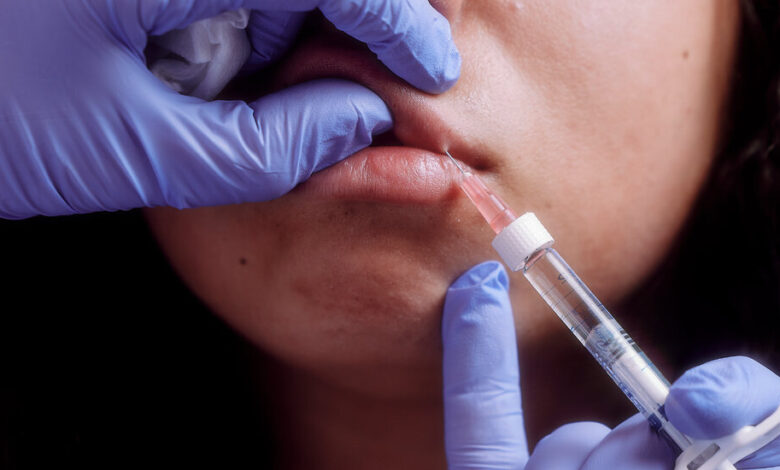Considering Lip Fillers? Here’s What to Know.

Gianna Palumbo always felt her lips were too small for her face. When she saw pictures on social media of women with lip fillers, she decided, at age 20, to get the injections done herself.
Ms. Palumbo, now 22, said people frequently compliment her lips — and when she thanks them, she also says where she got them done.
“I want to normalize it, because it’s not a bad thing to want to enhance something on your body,” said Ms. Palumbo, who lives in Buffalo, New York.
Lip fillers, in which hyaluronic acid is injected to make the lips more plump, have become more popular among younger patients like Ms. Palumbo. In a report from the American Academy of Facial Plastic and Reconstructive Surgery, nearly 75 percent of plastic surgeons surveyed said that they are seeing more people under 30 request injectables like lip fillers and other cosmetic procedures.
Some providers said they regularly see patients who make specific requests based on images they saw online, including of influencers who sometimes use photo or video filters to augment their features.Celebrities like Kylie Jenner have also sparked interest in lip filler in recent years.
“People are getting their education on social media,” said Dr. Ashley Amalfi, a Rochester-based plastic surgeon and chair of the American Society of Plastic Surgeons’ social media subcommittee. To counteract misinformation and provide context, she and her practice post on Instagram and TikTok about fillers and other procedures, and she encourages other surgeons to do the same.
If you’re thinking about getting lip filler, here’s what medical professionals want you to know.
Choose your provider wisely, and get a consultation.
Start with a consultation to share your goals and concerns, and learn what a provider can do in a safe and natural-looking way.
Look for a board-certified plastic surgeon or facial plastic surgeon, a dermatologist, or a medical professional who works directly under their supervision, experts said.
“If you’re going to a doctor’s office, chances are that they’re well-trained and using good products,” said Dr. Theda Kontis, a facial plastic surgeon in Baltimore and past president of the American Academy of Facial Plastic and Reconstructive Surgery. “If you go to a hotel room or a spa, you don’t know what they’re using,” or whether a trained medical professional is readily available if needed.
Consider what you want, and why.
Providers said that patients should avoid getting fillers to emulate beauty standards they see on social media, as those may not be safe, attainable or natural-looking for their face.
Dr. Amalfi said she always starts out conservatively, with just one syringe of filler, or even half a syringe, with the option to add more later. She does this to create a natural effect, and to make sure patients are comfortable with the change. She and other experts stressed that they make sure patients truly want and would benefit from fillers, and have realistic expectations about the results.
Say, for example, a patient feels her lips aren’t symmetrical. “If I see that and I agree with their assessment, and I believe I can make them happy, then I’ll do it,” Dr. Kontis said. But if they have very thin lips and want to look like Angelina Jolie, she said, “it’s just not going to happen.”
Know what to expect.
During the procedure, a provider will apply a numbing cream and then make several injections of hyaluronic acid to sculpt the lip. Even with numbing, the procedure can be painful, Dr. Kontis said. Sometimes doctors will also administer numbing injections in the mouth, like a dentist does.
Afterwards, your lips may be swollen and bruised; an ice pack can help reduce these symptoms. It will take about two weeks for the filler to settle.
If you don’t like the result, a provider can dissolve the filler with a different injection. Otherwise, your lips should return to their normal size in about six to 12 months. If you get fillers for years, Dr. Kontis said, your body will build up collagen in response, potentially increasing the “normal size” of your lips.
Research the health risks.
The biggest risk of the procedure is that the injector inadvertently hits a blood vessel. This can lead to a loss of blood supply to that area, and tissue death. “In experienced hands, it’s not likely to happen,” Dr. Kontis said.
Doctors advise against fillers for patients who are pregnant or breastfeeding, anyone with open sores, like from acne or a burn, and patients who have had allergic reactions to products in filler.
Additionally, people with a history of cold sores or fever blisters may need an antiviral medication after the procedure because the injections can cause flare-ups, Dr. Kontis said.
Some beauty companies and social media users have promoted hyaluron “pens” — which use high pressure to push hyaluronic acid into the skin — as needle-free alternatives to injections. But the Food and Drug Administration has warned against using these unregulated products, noting that they can cause infection, scarring and other serious complications.
Source link



